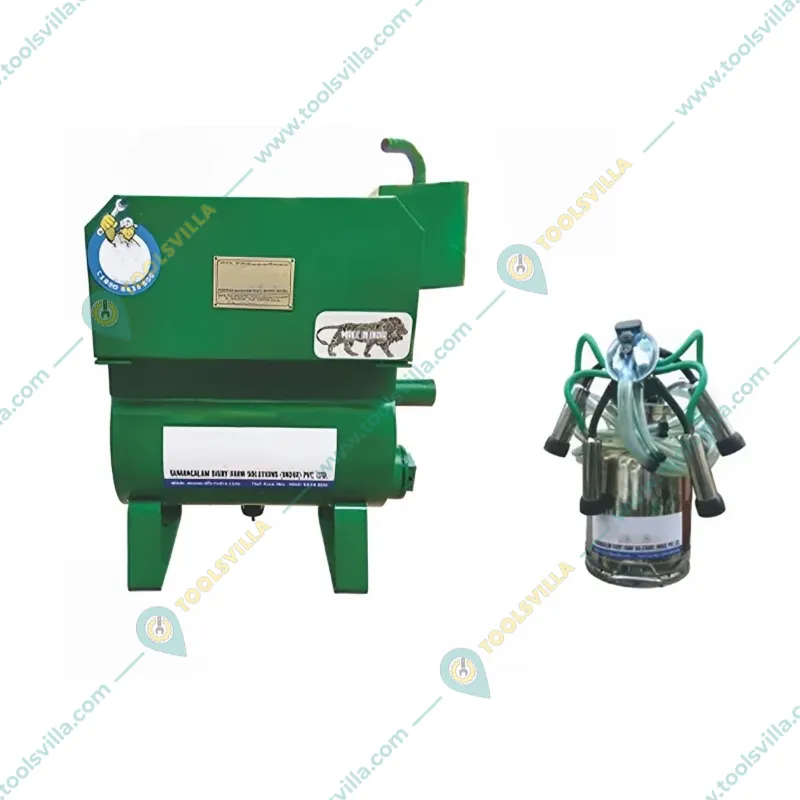
Brand: Generic ( Made in India )
Commercial 20L Milking Machine with 1HP Motor, 250 LPM
SKU: RD-SE-20234823
₹58580 (Including GST)
MRP : ₹74560
Get extra ₹879 Discount (On Checkout)
 Delivery By: Apr 7 - Apr 9
Delivery By: Apr 7 - Apr 9

Qty:

Easy Return
& Refund

Quality
Assurance

Trusted
Delivery

After Sales
Assistance

Buyer
Protection
Short Description
20L Milking Machine with 1HP Motor, 250 LPM
Semi-Automatic
Stainless Steel
Country of origin: India
Description
The Cow Milking Machine is a machine designed to automate the milking process, saving time and labor. This milking machine is made up of numerous components which assist in the extraction of milk from cows and buffaloes without causing any discomfort to them. The machine has a 1 HP motor, a 20-litre milking tank made of stainless steel, and a milking cluster that helps in the extraction of milk from the animals' udders. This machine is ideal for dairy farm owners and others who work with cattle and dairy farming.
Features
:- Comfort for Animals : The milking machine is designed to be comfortable for animals, without irritating their teats, tissues, or udder. They mimic the suckling action of a calf and apply a uniform pressure.
- Labor Savings : This milking machine can save on labor expenses and reduce the need for skilled farm workers. Thus, reducing both time and labor making it a suitable choice for dairy farm owners or individuals.
- High Build Quality : The milking machine bucket is made using stainless steel material which makes it food grade safe and enhances durability and strength.
Specification
:- Brand: Generic ( Made in India )
- Weight (Approx.) : 65 kg
- Material : Stainless Steel
- Motor Power : 1 HP
- Operation : Semi-Automatic
- Milk Extraction Applicable to : Cow & Buffalo.
- Productivity : 1-10 Cows per hour
- No. of Buckets : 1
- Storage Capacity : 20 Liters
- Bucket Material Grade : Stainless Steel (SS-304)
- Cleaning : Manual & Detergent
- No. of Nozzle : 01
- Dimension(L x W x H) : 450 x 300 x 540 mm
- Vacuum Pressure for Cow : 380 Kg/Cm²
- Vacuum Pressure for Buffalo : 400 Kg/Cm²
- Weight : 65 Kgs (Approx.)
Usage
:Step 1 : Preparing for Milking
- Clean the Milking Area : Sanitize the Milking area ensure the milking area is clean and sanitary to prevent contamination of the milk.
- Prepare the Equipment : Check the milking machine for any signs of wear and tear. Make sure all components are clean and functioning properly.
Step 2 : Setting Up the Milking Machine
- Connect the Vacuum Pump : Plug the pump into a power source and check that all connections are secure.
- Test the Vacuum : Before attaching the teat cups, test the vacuum system to ensure it is functioning correctly; there should be adequate suction.
- Adjust the Milking Pulsator : Set the pulsator rate according to the manufacturer's instructions.
Step 3 : Milking Process
- Position the Teat Cups : Guide each teat cup onto the respective teats gently and securely. Ensure that they are aligned properly to avoid any discomfort to the animal.
- Check for Proper Seal : Observe if the tea cups are holding their position without excessive pressure. A good seal will maintain the right suction.
- Observe Milk Flow : As the milking progresses, monitor the flow of milk through the milk line. A steady flow indicates that the suction is working effectively.
- Watch for Discomfort : Keep an eye on the animal for signs of discomfort. If the animal appears stressed or agitated, stop the process and reassess the machine setup.
- Signs of Completion : Detach the cups once the milk flow significantly slows or stops. This typically indicates that the udder is empty.
- Release Vacuum : Turn off the vacuum pump before removing the teat cups to avoid discomfort or injury to the animal.
Step 4 : Maintenance of Milking Machine
- Daily Cleaning : After each milking session, dismantle and wash all components with warm water and a suitable detergent. Rinse thoroughly to remove any residues.
- Regular Inspection : Check for wear and tear, especially on rubber components such as gaskets and liners. Replace them as needed to prevent leaks and ensure proper function.
- Periodic Servicing : Schedule regular professional maintenance checks on your milking machine to keep it in optimal condition.
Applications
:- Efficient Milk Extraction : Milking machines automate the process of milk extraction, significantly reducing the time required for milking compared to traditional hand milking methods. This efficiency allows farmers to milk more cows in less time, increasing overall productivity.
- Increased Milk Yield : The use of milking machines can lead to an increase in the quantity of milk produced per cow. The consistent vacuum applied by these machines can stimulate milk let-down more effectively than manual methods, resulting in higher yields during each milking session.
- Labor Savings : By mechanizing the milking process, dairy farms can reduce their reliance on skilled labor. This is particularly beneficial in regions where there is a shortage of experienced workers or where labor costs are high. Milking machines allow fewer workers to manage larger herds effectively.
 support@toolsvilla.com
support@toolsvilla.com Become a Seller
Become a Seller Download App
Download App Track Order
Track Order








